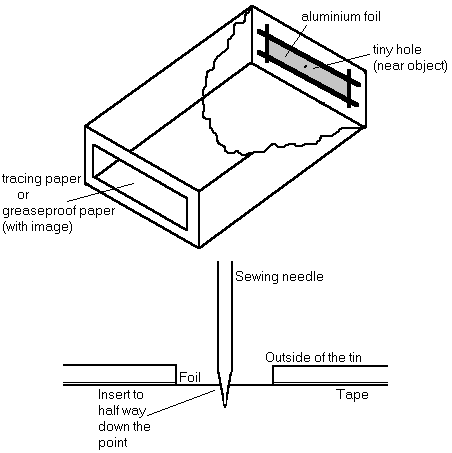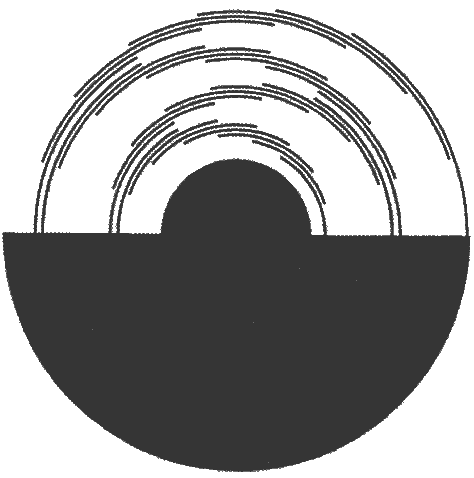
LIGHT AND OPTICS
Make a Pinhole Camera
- Safety rules:
- Parent supervision
- Take care with sharp objects
- Materials you need are:
- a cardboard box with a closely fitting lid (e.g. a shoe box)
- masking tape
- aluminium foil
- a sewing needle
- flat black water-soluble paint
- a paintbrush
- tracing paper or greaseproof paper
-

Paint the inside of the box with the black paint and allow to dry. Tape the lid onto the box so that no light can enter. Cut a hole 1.5 cm wide in the end of the box and carefully tape aluminium foil over the hole. Cut out a larger section at the other end of the box and masking tape a piece of tracing paper or greaseproof paper over the hole. Use a sewing needle to make a hole in the aluminium foil (The needle should be inserted only halfway along the point). To use your pinhole camera, you hold the end with the tiny hole in the aluminium foil up to the object at which you are looking. The image will appear on the tracing paper or greaseproof paper. What do you notice?
You should see an inverted image as the hole has acted like a lens.
Benham's Disc
- Safety rules:
- Parent supervision
- Take care with scissors
- Take care with electric drill and tools
- Materials you need are:
- a sheet of paper
- a black felt pen
- a disc made of cardboard
- glue
- scissors
- an electric drill (variable speed)
-

Copy or print out the Benham's Disc design. Glue it to a disc made of cardboard and attach it through the centre to a variable speed electric drill. Spin the disc under very bright incandescent light or sunlight. Fluorescent light is not recommended. At a certain speed, you should begin to see colours on you black-and-white disc.
Different people see different colours. The white flashes stimulate the colour-sensitive cells (red, blue and green cones) in the retina at the back of the eye. If all the cones were stimulated simultaneously, we would see white. However, some cones respond faster than others so we see colours.
Feather Rainbow
- Safety Rules:
- Parent supervision
- Take care with fire or heat
- Materials you need are:
- a candle
- matches
- a bird feather
Light a candle. Stand about 30cm away from it. Look through the feather's outer edge at the candle.
You should see tiny flames with rainbow colours. The white light of the candle flame is being refracted by the feather into the colours of the spectrum - red, orange, yellow, green, blue, indigo and violet.
Cool Cricketers
- Safety rules:
- Parent supervision
- Take care with the glass thermometers
- Materials you need are:
- 2 thermometers
- a white cloth
- a black cloth
- sunlight
Place the two cloths side by side in the sunlight. Place a thermometer under each cloth. Leave them for 15 minutes and read the thermometer readings.
Because white cloth reflects all light wavelengths and black cloth absorbs all light wavelengths and converts them to heat, the black cloth should be slightly hotter than the white cloth. This is why cricketers wearing white keep cool.
Tomato turns Black
- Materials you need are:
- a torch
- several pieces of coloured cellophane
- sticky tape
- coloured objects (e.g. tomato)
- a dark room
Cover the face of the torch with one colour of cellophane at a time and shine it on various coloured objects. What colour do they become?
Objects that we see appear that colour because a certain coloured wavelength/s is reflected off the object back to our eyes. If white light (made of red, yellow, green, blue, indigo and violet wavelengths of light) shines on a red tomato, only the red light is reflected back to our eyes. All other coloured lights are absorbed by the tomato.
However, if we shine green light on a red tomato in a dark room, there is no red light to be reflected from the tomato. It will appear very dark and lacking in colour.
Bisecting Mirror
- Safety rules:
- Parent supervision
- Take care with the mirror
- Materials you need are:
- one large mirror as tall as a person
- a friend
Hold the mirror upright and at right angles to your body and in front of it. Tell your friend to stand a little to your right so he/she can't see the left side of your body. Now lift you right. It will look to your friend like you are floating in thin air.
Many Mirror Images
- Safety rules:
- Parent supervision
- Take care with the mirrors
- Materials you need are:
- 3 flat mirrors
- objects to support the mirrors
- a small colourful object
Place the colourful object on the horizontal mirror and between the other two mirrors. How many images do you see? Now alter the angle between the upright mirrors and watch the images.
Polarised Sunglass Lens Blockout
- Materials you need are:
- an old pair of polaroid sunglasses (ask before using)
- a bright indoor light
Take the lenses out of the sunglasses. Hold one lens up to a bright indoor light (do not look at the sun) and observe how much light is blocked out. Now hold the other lens at right angles to the first and right next to it. How much light is blocked out?
The ability for light waves from the bright light to pass through the polaroid filters (lenses) depends upon the orientation of the filters. If one lens is in place, its filters block out waves in a horizontal direction. However when the second filter or lens is placed at right angles to the first, the second lens blocks out light waves in a vertical direction so all light is blocked by both.